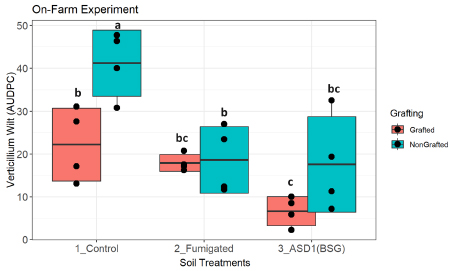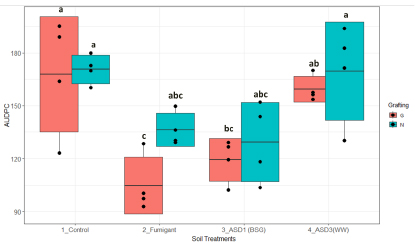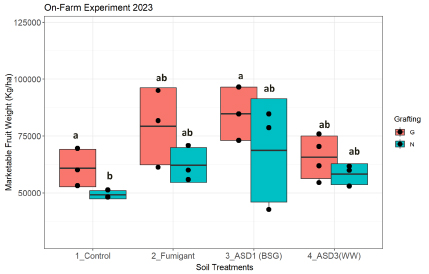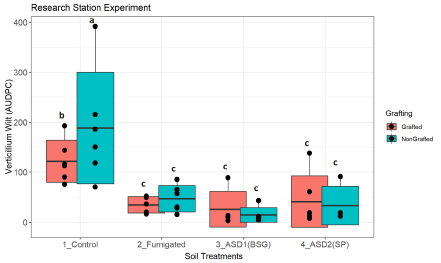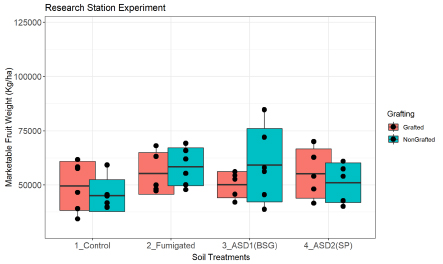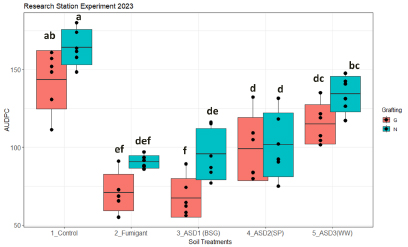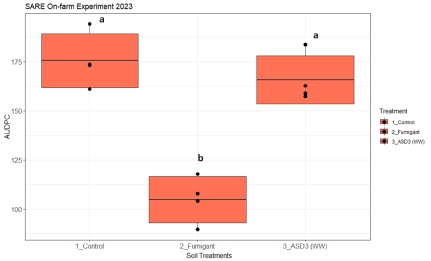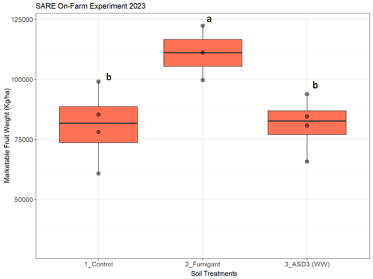Progress report for OS23-169
Project Information
Anaerobic soil disinfestation (ASD) consists of incorporating labile carbon sources, which are metabolized by soil microorganisms. This process develops anaerobic conditions in the soil reducing populations of soilborne pathogens. Local carbon sources accessible to farmers are needed to conduct ASD effectively in horticultural systems. The main objective of this study was to develop alternatives to fumigant-based systems available to growers for pre-plant treatment through ASD combined with grafting to reduce Verticillium wilt (VW) and improve soil health.
We propose to use carbon sources such as cover crops that are already part of the production systems of tomato growers. In NC, tomato growers finish tomato production around October and cover the soil planting winter wheat, legumes, or mixtures (winter peas, brassicas, rye, etc.) as cover crops. Then they incorporate these carbon sources into the soil, at least 2 months before tomato planting season (early spring). We propose that these cover crops can be incorporated into the soil and farmers can lay the plastic sooner than they usually do, initiating the ASD process earlier and keeping the plastic sealed until planting. This will allow anaerobic conditions to develop during the following weeks, reducing plant pathogen populations. Once the ASD process is complete, farmers can make holes in the plastic and proceed with planting tomato seedlings. In the past, the incorporation of cover crops has been hindered by the fact that root systems cannot be well incorporated and they affect good bed formation. However, a “reverse tiller” can be used which has a more forceful incorporation capacity with the reverse rotation leaving a deeper and cleaner bed in fewer passes than forward-rotating tines. Based on preliminary work and outcomes of objective 1, we envision growers may need to harvest cover crop residue from adjacent farm areas to supplement over-wintered growth in treated fields, in order to achieve the amount of carbon needed for maximum efficacy. Then ASD will fit into the already established production system of tomato farmers making its adoption easier and at a minimum cost. In addition, ASD has incredible potential to complement other practices such as grafting. Tomato rootstock such as “Maxifort” or “Beaufort'' show increased tolerance to V. dahliae infections, as well as increasing fungal species richness (Poudel et al. 2019). Field results from our group indicate that combining vigorous rootstocks with V. dahliae-resistant scions results in the highest yields in infested fields (Ingram, 2020). Combining ASD with resistant/vigorous rootstocks and resistant high-yielding scions should result in higher yields and lower disease severity. Comparing ASD and grafting with non-fumigated and fumigated treatments will allow us to determine the optimal practices for controlling V. dahliae in tomato field systems. This project provides novelty through the availability/development of novel genetics in emerging hybrids or rootstocks integrated into ASD systems using local carbon sources to suppress soilborne pests.
In 2022 and 2023, replicated field experiments were conducted on-farm in North Carolina (NC). The soil treatment (ST) was the main plot, and grafting (GrT) was the subplot. The ST was: 1) untreated control (UTC); 2) fumigation standard (Pic-Clor 60 rate of 0.168 Mg ha-1); 3) ASD1 using brewers spent grain (14 Mg ha-1); and 4) ASD2 using heat-treated sweet potato waste (12 Mg ha-1) 5) ASD3 using winter wheat (8 Mg ha-1) while the GrT subplots were grafted on the “Beaufort” rootstock or were non-grafted “Mountain fresh plus” tomatoes. There was a significant interaction between ST and GrT treatments on the reduction of VW severity (P<0.001) and an additive effect on yield improvement (ST, P<0.05 and GrT, P<0.001) with ASD using Brewers spent grain being similar to Pic-Clor 60 treated plots. Brewers spent grain is easily obtainable and inexpensive in NC; therefore, they can be used for ASD alone or in combination with other inexpensive carbon sources available throughout the season.
The main objectives of this project are to i) characterize and select an effective carbon source for ASD in greenhouse trials based on suppressing the viability of V. dahliae survival structures and ii) conduct multi-site, multi-year on-farm-research (OFR) field trials to develop non-fumigant-based systems using ASD to increase tomato yields and reduce soilborne pest pressure.
A minimum of two years of on-farm research experiments will be conducted to assess the efficacy of ASD using winter cover crops and local carbon sources, combined with grafting/host resistance compared to the grower standard and optimized fumigated treatments. We will conduct the trials in a VW-infested grower field (see letters of cooperation from growers and/or agents). We hypothesize the combination of ASD using winter cover crops and grafted plants will increase soil quality and reduce pathogen inoculum levels over time. In the on-farm work, the experimental design will be laid out as a randomized complete block design (RCBD) with a split-plot arrangement and 4 replications. The main plots will be soil treatment 1) an untreated control (UTC); 2) fumigation standard (Pichlor 60); 3) ASD1 using brewers spent grain and 4) ASD2 using winter wheat (Table1).
Table1. Potential field design for On-farm research
plots splots r Main_plot subplots
101 1 1 Fumigated Non-grafted
101 2 1 Fumigated Grafted
102 1 1 ASD2 Grafted
102 2 1 ASD2 Non-grafted
103 1 1 Control Non-grafted
103 2 1 Control Grafted
105 1 1 ASD1 Non-grafted
105 2 1 ASD1 Grafted
Each soil treatment plot will be three beds wide with a “Buffer Bed” in-between blocks. All data will be secured from the middle beds only. Each main plot is also separated by a buffer. Sub-plots will be transplanted to the grower standard tomato cultivar and up to two grafting treatments using rootstocks grafted to the grower standard scion. All grafted plants will be grafted by our team. Each unique treatment area will include a minimum of 10 plants to collect field data buffered by a minimum of 5 plants at each end of the treatment unit.
In our discussions, the grower indicated they would like to do work on a larger scale also (see Letter of Support - Leatherwood). To accommodate this extra gower goal, another trial will be conducted in which half of an acre will be managed according to grower standard practices and the other half of the acre will be produced by incorporating the winter cover crop using the reverse tiller, laying plastic, and saturating the field with water to induce anaerobic conditions until the planting day. We anticipate two treatments for this trial 1) Growers' standard practice and, 2) ASD using winter wheat as a cover crop. In addition, a parallel experiment will be conducted at a research station (Mountain Horticultural Crops Research and Extension Center, Mills River, NC) in a field with a history of high VW pressure. This will also be an RCBD experiment with main plots as above but include more subplots of grafted tomato. In the case of the research station work, the trial will be carried on to the third year. The first two years will secure data parallel to the on-farm work and will explore broader questions about the interactions of ASD, tomato genetics, microbial ecology, soil health, and tomato productivity. This research-station-based work will be funded primarily by other grants.
Procedure for field preparation: Soil will be prepared (disced, pre-plant fertilizer, pH adjusted) in advance by the grower. In our experience, we work with the grower who manages all equipment and calibrations, etc. In cases where cover crops are not used, Beds are pre-formed, and the carbon sources are placed on top of the pre-formed beds and rototilled into the bed to ensure thorough mixing; then in one pass, the soil is pulled, drip tape laid down and the bed is covered with TIF; fumigant is turned on or off according to soil treatment. For cover-crop treatments, existing cover crops (and supplemental cover crops if needed) will be added to the soils and incorporated, and then beds are pulled as above. Subsequently, lay flat tubing is rolled out and ½ inch of the non-perforated hose is fed to each ASD bed to saturate the ASD beds by splicing into the buried drip tape and capping the ends of the ASD area. Drip tape is “reattached” using connectors so lines can subsequently be used to water the entire bed row within a treated area. In our experience, this procedure has worked well. Redox and temperature values will be captured in selected plots using the Indicator of Reduction in Soils (IRIS) tubes (Rabenhorst 2010). Beds will be prepared in the early spring 2 months before planting tomatoes for a late crop (target planting date ~ first week of June).
Disease ratings will be conducted every week once the first symptoms appear during both year 1 and year 2, and disease ratings will be used to form an area under the disease progress curve (AUDPC) to optimally assess disease damage (Jeger and Viljanen-Rollinson 2001). Five harvests will be conducted, and fruit weight and size will be assessed. We will secure data from the inner 10 plants of the inner bed of each subplot; the grower will harvest all other fruit and can sell all fruit since all experimental inputs are registered/allowed. The grower will manage all day-to-day fertility, watering, training, and pest management.
Cooperators
- (Researcher)
- - Producer
- (Researcher)
- (Researcher)
Research
We conducted the trials in a VW-infested grower field. During on-farm work, the experimental design was laid out as a randomized complete block design (RCBD) with a split-plot arrangement and 4 replications. The main plots were the soil treatments1) an untreated control (UTC); 2) fumigation standard (Pichlor 60); 3) ASD1 using brewers spent grain and 4) ASD2 using winter wheat (Table1).
Table 1. Field design for On-farm research
plots splots r Main_plot subplots
101 1 1 Fumigated Non-grafted
101 2 1 Fumigated Grafted
102 1 1 ASD2 Grafted
102 2 1 ASD2 Non-grafted
103 1 1 Control Non-grafted
103 2 1 Control Grafted
105 1 1 ASD1 Non-grafted
105 2 1 ASD1 Grafted
Each soil treatment plot was formed by a bed wide with a “Buffer Bed” in-between blocks. All data was secured from the middle beds only. Each main plot was also separated by a buffer. Sub-plots were transplanted to the grower standard tomato cultivar “Mountain fresh plus,” and grafting treatments using rootstocks “Beaufort” grafted to the grower standard scion. All grafted plants were grafted by our team. Each unique treatment area included a minimum of 10 plants to collect field data buffered by a minimum of 5 plants at each end of the treatment unit.
In our discussions, the grower indicated they wanted to do work on a larger scale. To accommodate this extra grower goal, another trial was conducted in which half of an acre was managed according to grower standard practices, and the other half of the acre was produced by incorporating the winter cover crop using the reverse tiller, laying plastic, and saturating the field with water to induce
anaerobic conditions until the planting day. We set three treatments for this trial 1) Growers' standard practice and, 2) ASD using winter wheat as a cover crop, and 3) an untreated control (UTC).
Table 2. Field design for On-farm research on a larger scale
plots splots Main_plot
101 1 1 Fumigated
102 1 1 ASD1
103 2 1 Control
In addition, a parallel experiment was conducted at the Mountain Horticultural Crops Research and Extension Center, Mills River, NC, in a field with a history of high VW pressure. This was also an RCBD experiment with main plots as above but included more subplots of grafted tomato. The soil treatments were: 1) untreated control (UTC); 2) fumigation standard (Pic-Clor 60 rate of 0.168 Mg ha-1); 3) ASD1 using brewers spent grain (14 Mg ha-1); and 4) ASD2 using heat-treated sweet potato waste (12 Mg ha-1) 5) ASD3 using winter wheat (8 Mg ha-1) while the Grafting subplots were grafted on the “Beaufort” rootstock or were non-grafted “Red defender” tomatoes.
Table 3. Field design at the Mountain Horticultural Crops Research and Extension Center, Mills River, NC.
plots splots r Main_plot subplots
101 1 1 Fumigated Non-grafted
101 2 1 Fumigated Grafted
102 1 1 ASD2 Grafted
102 2 1 ASD2 Non-grafted
103 1 1 Control Non-grafted
103 2 1 Control Grafted
105 1 1 ASD1 Non-grafted
105 2 1 ASD1 Grafted
106 1 1 ASD3 Non-grafted
106 2 1 ASD3 Grafted
For the experiments, the grower prepared the soil (disced, pre-plant fertilizer, pH adjusted) in advance. In cases where cover crops were not used, beds were pre-formed, and the carbon sources were placed on top of the pre-formed beds and rototilled into the bed to ensure thorough mixing; then in one pass, the soil was pulled, drip tape laid down and the bed was covered with TIF; fumigant was turned on or off according to soil treatment. Existing cover crops were added to the soils and incorporated for cover-crop treatments, and then beds were pulled as above. Subsequently, lay flat tubing were rolled out and ½ inch of the non-perforated hose was fed to each ASD bed to saturate the ASD beds by splicing into the buried drip tape and capping the ends of the ASD area. After the ASD time-period, drip tape was “reattached” using connectors so lines could subsequently be used to water the entire bed row within a treated area. Redox and temperature values were captured in selected plots using the Indicator of Reduction in Soils (IRIS) tubes (Rabenhorst 2010). Beds were prepared in the early spring 2 months before planting tomatoes for a late crop (target planting date ~ first week of June).
Disease ratings were conducted every week once the first symptoms appeared during both year 1 and year 2. They were used to calculate the area under the disease progress curve (AUDPC) to optimally assess disease damage (Jeger and Viljanen-Rollinson 2001). Five harvests were conducted, and fruit weight and size were assessed. We secured data from the inner 10 plants of the inner bed of each subplot.
Disease progression and yield for 2022
On-farm experiment in 2022
In the on-farm experiment conducted in 2022, this study found that there were significant effects of grafting (p < 0.0001) and soil treatments (p < 0.0001) on the progression of Verticillium wilt. Additionally, it was discovered that the effects of soil treatment may vary depending on whether a plant is grafted or not, or vice versa (interaction effect p = 0.001).
The study also compared different treatment and grafting combinations and found that the Non-grafted with Non-Fumigated combination showed the highest Verticillium wilt progression (AUDPC value = 41), while Grafted with Fumigated, Non-grafted with ASD using SpentGrain, and Grafted with ASD using SpentGrain showed low progression of Verticillium wilt ranging from 7 to 17 (Figure 1 A).
Moreover, the study revealed that soil treatments (P <0.05) and grafting (P < 0.0001) had significant effects on the measured outcome, while the interaction effect between them was not statistically significant (P = 0.45). Among the different soil treatments and grafting combinations, Fumigated with Grafted and SpentGrain with Grafted had the highest estimates at 92,542 and 80,997 kg per ha, respectively. On the other hand, Non-fumigated control with non-grafted plants yielded the lowest estimate at 47,719 kg per ha (Figure 1 B).
Figure 1. Effect of anaerobic soil disinfestation (ASD) and grafting on Verticillium disease progression during On-farm trials in fresh tomato production at Canton, NC in 2022 (A) Verticillium disease progression caused by Verticillium dahliae. (B) Marketable yields of fresh tomato cv. “Mountain fresh plus”. Treatments were: Control = non-amended non-saturated plastic covered control; ASD1 = plastic covered saturated amended with Brewers spent grain (BSG) at 14 Mg ha−1; Fumigant = Chemical fumigant Pichlor 60, with Chloropicrin as the active ingredient (a.i.) with a rate of 0.17 Mg ha-1; Grafting treatment consists of rootstock cv. Beaufort and scion cv. “Mountain fresh plus”. Boxes represent the quartile distribution with the black dash as the median, the whiskers as the maximum and minimum values, and white dots as outliers. Points represent the mean data of four replicates. Values indicated by different letters are significantly different at p < 0.05 according to Tukey’s test.
Research station experiment in 2022
The results of the Research Station experiment in 2022 show that grafting (p = 0.01), soil treatment (p < 0.0001), and their interaction had significant effects on disease progression (p = 0.001). The combination of Non-Grafted with Non-Fumigated resulted in the highest Verticillium wilt (190), closely followed by Grafted with Non-Fumigated with an estimate of 123. Moreover, Non-Grafted with Fumigated, Grafted with SweetPotato, Non-Grafted with SweetPotato, Grafted with Fumigated, Grafted with SpentGrain, and Non-Grafted with SpentGrain showed estimates ranging from 47 to 15 (Figure 2 A).
Although neither soil treatment nor grafting nor their interaction significantly impacted yield in this study, there was a numerical trend. However, an early frost in October prevented obtaining a complete harvest. Fumigated with Non-Grafted and SpentGrain with Non-Grafted exhibited the highest estimates at 59,602 and 58,384 kg/ha, respectively (Figure 2 B).
Figure 2. Effect of anaerobic soil disinfestation (ASD) and grafting on Verticillium disease progression during On-farm trials in fresh tomato production at Canton, NC in 2023 (A) Verticillium disease progression caused by Verticillium dahliae. (B) Marketable yields of fresh tomato cv. “Mountain fresh plus”. Treatments were: Control = non-amended non-saturated plastic covered control; ASD1 = plastic covered saturated amended with Brewers spent grain (BSG) at 14 Mg ha−1; ASD3 = plastic covered saturated amended with winter wheat (WW) at 8 Mg ha−1; Fumigant = Chemical fumigant Pichlor 60, with Chloropicrin as the active ingredient (a.i.) with a rate of 0.17 Mg ha-1; Grafting treatment consists of rootstock cv. Beaufort and scion cv. “Mountain fresh plus”. Boxes represent the quartile distribution with the black dash as the median, the whiskers as the maximum and minimum values, and white dots as outliers. Points represent the mean data of four replicates. Values indicated by different letters are significantly different at p < 0.05 according to Tukey’s test.
On-farm experiment in 2023
During the on-farm experiment conducted in 2023, a significant effect of soil treatment on the progression of Verticillium disease was observed (P < 0.0001). However, the effects of grafting (P = 0.05) and the interaction between grafting and treatment (P = 0.5) were not statistically significant. The combination of grafting with fumigation (105) or ASD using brewer's spent grain (119) resulted in the lowest disease progression, which was statistically different from the nongrafted untreated control (171) (Figure 3 A).
Similarly, the ANOVA conducted in the same study showed that both grafting (P < 0.05) and soil treatments (P < 0.05) had significant effects on yield, while the interaction effect between grafting and treatments was not significant (P = 0.9) . Among the grafting treatments, plants grafted with soils treated with ASD using brewer's spent grains (BSG) yielded the highest (75,550 kg/ha), which was significantly different from the grafted untreated control (43,786 kg/ha). This combination was also statistically similar to grafting combined with fumigation (70,671 kg/ha) (Figure 3 B).
Figure 3. Effect of anaerobic soil disinfestation (ASD) and grafting on Verticillium disease progression during trials at Mountain Horticultural Crops Research Station, Mills River, NC in 2022 (A) Verticillium disease progression caused by Verticillium dahliae. (B) Marketable yields of fresh tomato cv. “Red Defender”. Treatments were: Control = non-amended non-saturated plastic covered control; ASD1 = plastic covered saturated amended with Brewers spent grain (BSG) at 14 Mg ha−1; ASD2 = plastic covered saturated amended with Sweetpotato waste (SP) at 12 Mg ha−1; Fumigant = Chemical fumigant Pichlor 60, with Chloropicrin as the active ingredient (a.i.) with a rate of 0.17 Mg ha-1; Grafting treatment consists of rootstock cv. Beaufort and scion cv. “Red Defender”. Boxes represent the quartile distribution with the black dash as the median, the whiskers as the maximum and minimum values, and white dots as outliers. Points represent the mean data of four replicates. Values indicated by different letters are significantly different at p < 0.05 according to Tukey’s test.
Research station experiment in 2023
The study conducted on the Research station in 2023 revealed significant effects of both grafting (p < 0.0001) and soil treatment (p < 0.0001) on Verticillium wilt progression. The interaction effect between grafting and soil treatment was not significant (p = 0.2). Among the different treatments, Non-Grafting with soil untreated control exhibited the highest disease progression (164). Grafting with soil untreated control showed a disease progression of 143. Finally, Grafting with Fumigant or with ASD1(BSG) yielded the lowest disease estimates at 71 and 67, respectively (Figure 4 A).
Another finding from the same experiment was that the effect of grafting was found to be statistically significant (p <0.001) on yield, indicating that grafting generally results in higher yields. Similarly, the effect of soil treatments was also significant (p <0.01), demonstrating that the different soil treatments applied had an additive impact on the yield. Additionally, the interaction effect between Grafting and soil treatment was not found to be significant (p = 0.2343), suggesting that the combined influence of grafting technique and soil treatments did not lead to a significantly higher yield beyond what would be expected from their individual effects, but rather an additive effect on yield.
Results showed that Grafting with ASD using Brewers' spent grain (BSG) as a carbon source displayed the highest yield, 85,717 kg/ha. However, this combination yield was only statistically different from the non-grafted tomatoes combined with ASD using winter wheat (WW) and the non-treated control. Grafting combined with fumigation or ASD using winter wheat generated significantly higher yields than the non-grafted non-treated control (Figure 4 B).
Figure 4. Effect of anaerobic soil disinfestation (ASD) and grafting on Verticillium disease progression during trials at Mountain Horticultural Crops Research Station, Mills River, NC in 2023 (A) Verticillium disease progression caused by Verticillium dahliae. (B) Marketable yields of fresh tomato cv. “Red Defender”. Treatments were: Control = non-amended non-saturated plastic covered control; ASD1 = plastic covered saturated amended with Brewers spent grain (BSG) at 14 Mg ha−1; ASD2 = plastic covered saturated amended with Sweetpotato waste (SP) at 12 Mg ha−1; ASD3 = plastic covered saturated amended with winter wheat (WW) at 8 Mg ha−1; Fumigant = Chemical fumigant Pichlor 60, with Chloropicrin as the active ingredient (a.i.) with a rate of 0.17 Mg ha-1; Grafting treatment consists of rootstock cv. Beaufort and scion cv. “Red Defender”. Boxes represent the quartile distribution with the black dash as the median, the whiskers as the maximum and minimum values, and white dots as outliers. Points represent the mean data of four replicates. Values indicated by different letters are significantly different at p < 0.05 according to Tukey’s test.
On-farm trials on a larger scale in 2023
The study's results showed that soil treatment had a significant impact (p < 0.0001) on the progression of Verticillium wilt disease. This suggests that the different treatment methods used significantly affected the disease. The untreated Control and ASD3 (WW) treated soils had similar Verticillium wilt disease progression, and both were significantly higher than the disease progression associated with Fumigant-treated soils. This indicates that Fumigant treatment is an effective method for reducing the progression of the disease (Figure 5 A).
Additionally, the ANOVA showed that there were distinct treatment effects on tomato marketable yield (P<0.05). The Fumigated plots with Pic 60 had the highest yield (99,081 kg/ha). However, there was no significant difference in yield values between ASD using Winter wheat (WW) and the control treatment, which both had estimated yields of 72,470 and 72,077 kg/ha, respectively (Figure 5 B).
Figure 5. Effect of anaerobic soil disinfestation (ASD) and grafting on Verticillium disease progression during On-farm trials on a larger scale in fresh tomato production farms at Canton, NC in 2023. (A) Verticillium disease progression caused by Verticillium dahliae. (B) Marketable yields of fresh tomato cv. “Mountain fresh plus.” Treatments were: Control = non- amended non-saturated plastic covered control; ASD3 = plastic covered saturated amended with winter wheat (WW) at 8 Mg ha−1; Chemical fumigant Pichlor 60, with Chloropicrin as the active ingredient (a.i.) with a rate of 0.17 Mg ha-1; Grafting treatment consists of rootstock cv. Beaufort and scion cv. “Mountain fresh plus”. Boxes represent the quartile distribution with the black dash as the median, the whiskers as the maximum and minimum values, and white dots as outliers. Points represent the mean data of four replicates. Values indicated by different letters are significantly different at p < 0.05 according to Tukey’s test.
Educational & Outreach Activities
Participation Summary:
There is an urgent need to fill the existing knowledge gap in alternative management of soilborne pathogens of tomatoes in NC. Building a partnership with the tomato grower during on-farm research will provide the opening for both short- and long-term collaborations and training opportunities that will help generate resources and tools for the efficient and sustainable production of tomatoes in NC. We have extensive extension experience and regularly meet with growers, and industry representatives. Proposed outreach will be in the form of field days, grower meetings, and a workshop. We will publish the extension publications and a web-based tomato disease extension sheet (in English and Spanish). We will also develop an innovative online outreach tool based on soil health analysis. We also envision an even greater web presence, making use of webinars and digital education.
A presentation at the winter vegetable conference in Asheville, NC is planned to cover the tomato production systems affected by the loss of MB and the key pests currently managed using ASD. This will include overviews of soil-borne pathogens, nematodes, and weeds that are serious issues in crops such as tomatoes, and other vegetables. In addition, we anticipate also taking part in Tomato Field Day 2023 will be held at the Mountain Horticultural Crops Research and Extension Center (Read more at: https://buncombe.ces.ncsu.edu/2022/07/tomato-field-day-2022/). A portion of that training will be devoted to discussing on-farm trials, their importance to research and extension programs, and associated implementation difficulties. The economics of losing MeBr and the use of replacement strategies will be highlighted, particularly for tomato production systems. The agents will also secure materials to take home. A notebook containing handouts from the various speakers will be given to each of the participants. Our goal is to capitalize on our working relationships amongst the growers and with extension and expert support; we envision these groups will endure solving not only fumigation transition issues but other applied needs such as variety testing and implementation of IPM practices.
Learning Outcomes
Farmers gained valuable insights from these results regarding effective strategies for managing Verticillium Wilt (VW) and optimizing yield in agricultural settings. The significant interaction observed between soil treatments and grafting treatments underscores the importance of considering the combined effects of different treatments rather than relying solely on individual approaches. Moreover, the additive effect on yield improvement indicates that utilizing both soil treatments, such as ASD and grafting treatments, can lead to greater yield enhancements than using them separately. The similarity between ASD and Pic-Clor 60 treated plots highlights the potential of utilizing readily available and cost-effective materials such as brewers' spent grain and sweetpotato waste for soil disinfestation. This suggests that farmers can capitalize on these inexpensive carbon sources for ASD treatments, either alone or in conjunction with other affordable options, throughout the growing season. These findings provide farmers with practical insights into sustainable and cost-efficient methods for disease management and yield optimization in their farming operations.
Project Outcomes
Optimized Disease Management Protocols: Farmers could develop and implement optimized disease management protocols tailored to their specific crops and conditions. By understanding the interaction between different treatments, such as anaerobic soil disinfestation and grafting, and their interaction effects on disease reduction, farmers can design more effective strategies for managing Verticillium Wilt and other soil-borne diseases.
Enhanced Crop Yields: Implementation of the identified treatments, either individually or in combination, could lead to significant improvements in tomato yields. By leveraging the additive effect observed in yield improvement, farmers may achieve higher productivity levels, resulting in increased profitability and sustainability of their agricultural operations.
Cost-Effective Soil Disinfestation Techniques: The utilization of brewers' spent grain, sweetpotato waste, and winter wheat for anaerobic soil disinfestation (ASD) presents a cost-effective and sustainable approach to soil health management. We developed guidelines or recommendations for farmers on the optimal application of these readily available carbon sources for ASD treatments, thereby reducing reliance on expensive chemical inputs. Fact sheet: https://content.ces.ncsu.edu/anaerobic-soil-disinfestation-for-management-of-soilborne-pathogens-in-tomato-production
Promotion of Sustainable Agriculture Practices: We promoted sustainable agriculture practices by emphasizing the use of environmentally friendly and locally sourced materials for disease management and soil health improvement. By showcasing the efficacy of these practices, the project could inspire broader adoption of sustainable farming methods within the NC tomato growers community.
Knowledge Sharing and Collaboration: We disseminated the project outcomes through workshops, extension programs, or publications (see project products).
PROJECT PRODUCTS
Posters
Anaerobic soil disinfestation using locally available carbon sources reduces Verticillium dahliae microsclerotia viability in NC tomato fields. Andres D. Sanabria, Thomas W. Ingram, Tika Adhikari, and Frank J. Louws, North Carolina State University, Raleigh, NC. https://apsjournals.apsnet.org/doi/10.1094/PHYTO-113-9-S2.30
Talks
Effects of anaerobic soil disinfestation combined with grafting on Verticillium wilt and nematode communities in North Carolina tomato fields. https://events.rdmobile.com/Sessions/Details/1849074
Anaerobic Soil Disinfestation on Tomatoes - 56th Annual Winter Vegetable Conference. https://mountainhort.ces.ncsu.edu/event/1933525811/winter-vegetable-conference-in-asheville/
2023 Mtn Hort Field Day https://mountainhort.ces.ncsu.edu/2023/04/mtn-hort-crops-field-day-2023/
Management of soilborne diseases in tomato: Verticillium, Fusarium, bacterial wilt and RKN: 35th Southeast Vegetable & Fruit Expo. Durham NC.
Fact sheets
Anaerobic Soil Disinfestation for Management of Soilborne Pathogens in Tomato Production. https://content.ces.ncsu.edu/anaerobic-soil-disinfestation-for-management-of-soilborne-pathogens-in-tomato-production
Desinfestación anaeróbica del suelo para el manejo de enfermedades transmitidas por el suelo en la producción de tomate. https://content.ces.ncsu.edu/desinfestacion-anaerobica-del-suelo-para-el-manejo-de-enfermedades-transmitidas-por-el-suelo-en-la-p
Information Products
- Anaerobic soil disinfestation using locally available carbon sources reduces Verticillium dahliae microsclerotia viability in NC tomato fields. (Conference/Presentation Material)
- Anaerobic Soil Disinfestation for Management of Soilborne Pathogens in Tomato Production (Fact Sheet)
- Desinfestación anaeróbica del suelo para el manejo de enfermedades transmitidas por el suelo en la producción de tomate (Fact Sheet)
